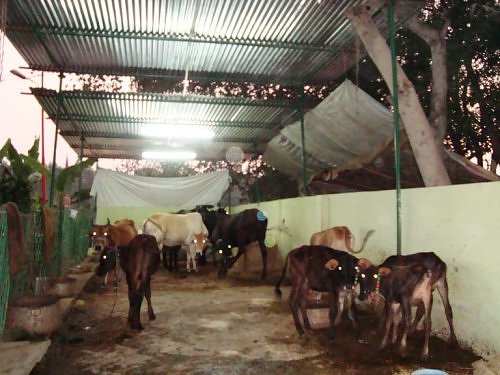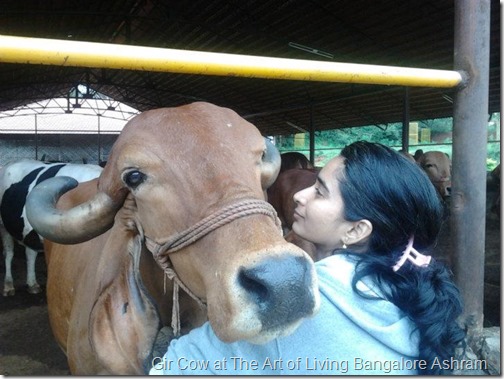Why A2 milk is good for health and the national economy
A2 milk was once the basis of healthy living for people, the environment as well as economic prosperity of the agrarian Indian economy. There are over 6 lakh villages in India, and each one of them has a large tract of land, officially called the ‘Gauchar bhoomi’ for the last thousands of years. This land is even now meant for cattle grazing for the entire village’s cattle. This Gauchar bhoomi ensured well grazed healthy cattle. There was no need for a mechanised factory like environment where urban cattle is now kept.
The A2 milk was not the only valuable resource, either! Dung and urine from Indian cattle was used for medicinal and organic farming practices. Blessed with the Vedas and climatic conditions suitable for 3 harvest seasons in most parts of India, resulted in an annual calendar marked with dozens of harvest festivals all over the country. Agriculture was a science, hugely supported by its cattle in India.
Re-emergence of chemical free farming for sustainable living
The re-emergence of ancient Indian agricultural practices: prayers before planting seeds, Agnihotra at sunrise and sunset with Sanskrit mantras and select offerings into the fire, organic formulae for manures and pesticides that multiplied the good bacteria in the soil to continuously provide valuable soil nutrients, etc., is attracting the educated urban and rural youth to explore farming as a respectable occupation.
Farming is now an attractive occupation because the Indian cow is back in its center!
When the cattle is back where it belongs, can money be far behind? Ordinary milk is selling at approximately Rs 50 per litre in Delhi, whereas A2 milk is selling at approximately Rs 160 per litre. Similarly, organically grown food is selling at a higher price than inorganically grown food. The supply is less than demand.
Even though tractors and commercial harvesters have replaced the oxen for tilling, etc. agricultural activities, the dung and urine contributed by calves, bulls and oxen is a huge asset in making all-natural manures like Jivamrut, Bijamrut, Panchagavya, etc. In organic agriculture, dung was simply turned into compost. The re-emergence of ancient Indian agricultural practices has these formulae where the same amount of dung that was composted to supported a certain piece of land, can now be used to nourish 100 times the land size. It is no wonder that the Indian cow’s family was revered for the prosperity and good health it brought for humans, environment and the nation’s economy.
Plentiful harvests, led to trade of surplus products and byproducts building up the gold reserves that Indian households still have, to make them world leaders in privately owned gold even today. The state owned treasures of gold, silver and precious stones may have been taken away repeatedly by conquerers, but the land yielded gold again and again because of the availability of cattle in villages of India, the three harvest seasons and knowledge of soil and water conservation techniques.
There are over 39 varieties of indigenous Indian cows. The title, ‘Gaumata’ was given in reverence and gratitude to these nourishers of the earth. They may not be easy to find in urban India other than gaushalas managed by temples or dairy farms aware of the benefits of A2 milk. Some breeds are near extinction in India, while others are A2 milk providers to Brazil, U.S.A, Australia, Kenya and other countries.

List of cows of India that produce A2 milk:
- Alambadi breed is found in Tamil Nadu and Karnataka
- Amrit Mahal breed orginated in Mysore, Karnataka
- Bachaur breed originated in Madhubani, Darbhanga and Sitamarhi districts of Bihar
- Bargur is a breed of cattle native to the Bargur forest hills of Erode district in Western Tamil Nadu
- Brahman breed was created in the USA in the early 1900s by cross breeding 4 breeds that were imported from India between 1854 and early 1900s, namely: Gir, Gujarat, Krishna Valley and Ongole or Nellore breeds. Brahman is the most popular breed in the U.S.A and 50% of the Australian cattle is now of Brahman breed too.
- Dangi breed is found in Nasik and Ahmednagar districts of Maharashtra
- Deoni breed originated in Bidar district of Karnataka and neighbouring Latur district of Maharashtra
- Gangatiri breed is found in eastern Uttar Pradesh and neighbouring Bihar, along the river Ganga
- Gaolao breed is found in Wardha district of Maharashtra, Balaghat and Chindwara districts of Madhya Pradesh and Rajnandgaon district of Chattisgarh.
- Gir breed is found in Gujarat, but is said to be from the herd of Krishna’s father Nand ji Maharaj of Gokul, Vrindavan in Uttar Pradesh. Gir breed was imported as early as the year 1850 and are termed Zebu cattle like the imported Ongole and Kankrej. Pedigreed Gir cows in Brazil get the ‘Pure Origin India’ tag (POI), and every animal's pedigree and DNA is registered with the Association of Brazilian Zebu Breeders.
- Hallikar breed comes from the Hallikar belt of Mysore, Mandya, Hassan and Tumkur districts of South Karnataka. The Department of Post, Government of India released a postal stamp featuring the Hallikar breed in year 2000.
- Hariana breed, found in Haryana and eastern Punjab, is one of the 75 known breeds of zebu (Bos indicus) cattle. Zebu cattle is identified as Indian and African breeds, thought to be derived from Asian aurochs, subspecies Bos primigenius namadicus. Wild Asian aurochs disappeared during the time of the Indus Valley Civilization possibly due to interbreeding with domestic zebu and drying of the River Saraswati and the resulting loss of habitat.
- Javari breed is native to North East Karnataka
- Kangayam breed gets its name from Kangeyam town in Tiruppur district of Tamil Nadu. It is a winner in Jallikattu, and used in breeding good cattle. Popular import to countries that prize Indian origin cattle.
- Kankrej breed is from Banaskantha district of Gujarat. It was imported to Brazil and a new breed by the name of Guzerat was created in Brazil.
- Kasaragod Dwarf breed is Kasaragod district from Kerala
- Kathiawadi is a breed from Gujarat.
- Kenkatha or Kenwariya breed is from Bundelkhand region in Uttar Pradesh and along the banks of River Ken in the Vindhya Hill Range of Madhya Pradesh
- Kherigarh breed is from Lakhimpur district in Uttar Pradesh
- Khillari breed is from Satara, Kolhapur and Sangli districts of Maharashtra and Bijapur, Dharwad and Belgaum districts of Karnataka
- Krishna Valley breed is from along the banks of Rivers Krishna, Ghatprabha and Malaprabha in the Bijapur, Bagalkot and Belgaum districts of Karnataka
- Malnad Gidda, Malenadu Gidda, Uradna or Varshagandhi breed is from the hilly, rainy and densely forested Malenadu region of the Western Ghats in Karnataka. It can thrive solely on grazing too.
- Malavi, Manthani or Mahadeopuri breed is from the Malwa plateau in wetsern Madhya Pradesh.
- Mewati or Kosi breed is from Mewat in Haryana.
- Nadudana or MIniature Zebu breed is from islands in Southern India
- Nagori breed is from Nagaur district of Rajasthan
- Nellore breed of Brazil originated from the Ongole breed from Nellore district in Andhra Pradesh. A pair was first imported to Brazil in the year 1868. Now, approximately 80% of Brazilian cattle is of Nellore breed and it exports them to U.S.A., Venezuela and other countries.
- Nimari breed is from Nimari region (Narmada and Tapi river valleys) of Khandwa in Madhya Pradesh and Jalgaon district of Maharashtra
- Ongole breed from Ongole region (surrounding the Rivers Gundlakamma, Musi and Paleru) in Andhra Pradesh and its derivatives are a world leader in A2 milk production in countries including Brazil, U.S.A., Argentina, Paraguay, Columbia, Mexico, West Indies, Netherlands, Fiji, Mauritius, China, Malaysia, Indonesia and Phillipines. Ongole bull is popular in Jallikattu in India and Bull fighting in Mexico.
- Ponwar breed comes from Puranpur Taluk in district Pilibhit of Uttar Pradesh
- Pulikulam breed gets its name from Pulikulam village in Sivagangai in Tamil Nadu. It is popular in Jallikattu. It is also called Palinga Maadu, Mani maadu Jallikattu maadu and Kilakattu maadu.
- Punganur dwarf breed is from Chittoor district of Andhra Pradesh. 200 members of this breed are taken care of at the Tirumala Tirupati Temple Gaushala. The milk of these cows is used for offering to the Divine here since the year 966 A.D. This breed is otherwise nearly extinct. It is the smallest humped cattle breed in the world.
- Rathi and its variant Rath breed come from Bikaner, Ganganagar, Hanumangarh and Alwar districts of Rajasthan.
- Red Kandhari or Lal Kandhari originated in Kandhar Taluk in Nanded district, Latur and Parbhani districts of Marathwada region in Maharashtra, and North Karnataka districts.
- Sahiwal breed comes from Punjab, along the India-Pakistan border. It was imported by New Guinea and Australia in the 1950s. It helped developed the two breeds Australian Milking Zebu and Australian Friesian Sahiwal. Sahiwal breed has also contributed to the dairy industry in Kenya, Jamaica, Guyana, Burundi, Somalia, Sierre Leone, Nigeria and several ecological zones of Africa where they have been crossed with exotic local breeds.
- Siri breed from Bhutan is found in Sikkim and Darjeeling.
- Tharparkar, White Sindhi, Cutchi or Thari breed is from the Thar desert of Rajasthan in India and adjoining Sindh province of Pakistan.
- Umblachery breed is native to Nagapattinam and Tiruvarur districts of Tamil Nadu.
- Vechur breed is from Vechoor village in Kottayam district of Kerala
In ancient India, killing them for meat was killing the proverbial golden goose, and such a person was severely punished by the state and society. The state of Sikkim in India is already a 100% organic farming state with good support for its farmers. Other states are building resources to follow suit at their own pace. The farmers in India would benefit greatly, if the goverment could provide a structured support system for educating them once again about water conservation practices, and provide organic manures like Jivamrut and Panchagavya instead of subsidising inorganic chemical fertilizers like they do now. Farmers are ready to use organic practices if they get a steady supply of healthy seeds, organic manures, pesticides, water conservation support and transport for selling the produce. The government doesn't even need to look beyond the village for providing this support. The Gauchar bhoomi in each village could be the right place to support local cattle in shelters and produce manures and pesticides for the whole village.
A2 milk and organically grown food can bring back health for the people, the environment and economy, the Ayurvedic way:) Eat healthy, live healthy. Annadata Sukhi Bhavah :)


